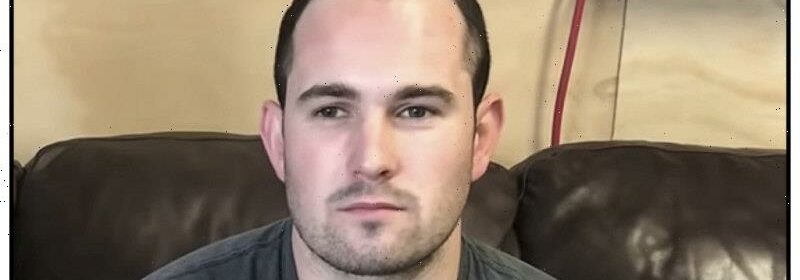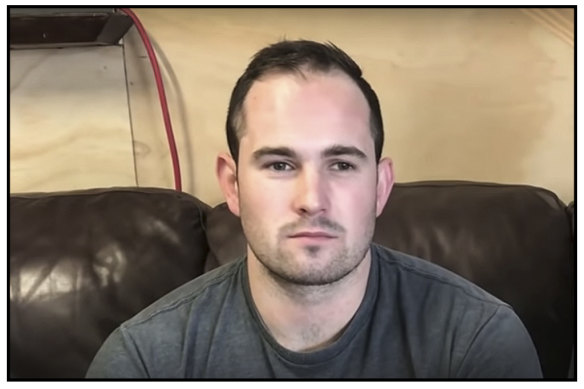Nazi salutes and the view from nowhere

Tom Sewell is one of the most odious individuals in Australia. He runs a Nazi cell, he’s a racist and violent man who attracts other lost, violent men to his “cause”. This week he was sentenced by the Victorian courts after he entered a corporate building (the one I work in), made a pest of himself, then punched to the ground the Nine security guard who tried to escort him out – after Sewell’s mate had called the guard, who was born in the Dominican Republic, a “monkey”.
National Socialist Network leader Tom Sewell.Credit:
On Thursday, a magistrate sentenced Sewell to an 18-month community correction order. No jail time was ordered because Magistrate Stephen Ballek was not persuaded that the attack was racially motivated. Shortly afterwards, Sewell stood in front of the media, said: “Australia for the white man”, and flashed a Nazi salute.
The question for us at The Age was whether to publish a picture of that salute. The argument against was that Sewell wanted us to. He would gloat about it, use it as a recruiting tool. The argument for publishing was to show what a cretin he really is and to invite our readers to come to a similar judgment.
I don’t like withholding a relevant fact (Sewell’s overt Nazism) from a large number of people because he might use it to win a small number of supporters. Of course, we described the salute. But, under a “first do no harm” approach, we reluctantly decided not to publish the picture. I’m still not sure it was the right call. We also blur swastikas as a uniquely offensive symbol. Others did picture the salute, including the Herald Sun, the News Corp websites and at least one TV station – Nine.
It’s a small example of a much broader debate in journalism. We don’t publish graphic pictures of dead bodies. Some disagree: war is horrible, there are grisly consequences, people should know. But, out of sensitivity to our audience, we look for something that tells the story without being traumatising. We publish “graphic content” warnings on other gruesome material, and potentially emotionally triggering statements are accompanied by contact details for services such as Lifeline.
There are strong moves in broader society and within the media to limit some other facts too. New Zealand Prime Minister Jacinda Ardern encouraged us all in 2019 not to name the Christchurch mosque terrorist, and instead to speak the victims’ names.
“He sought many things from his act of terror but one was notoriety,” she told parliament. The media in New Zealand, and some outlets internationally followed suit.
Some of this makes me uncomfortable. My starting point is to provide as much information as possible so people can make up their own minds. I’m likewise suspicious of the “platforming” and “deplatforming” movement which, again, argues for some people or topics to be off limits because they transgress certain norms. The Age publishes all sorts of things that I disagree with in the name of open debate and I think that’s good.
That said, there are limits. We would never publish hate speech. Some norms should not be transgressed. And the question for us (which arose around the salute photo) is where the limits lie.
The idea that by reporting an event we are “promoting” someone’s narrative gives rise to an even more complex question. When should we, in our news stories, allow people to make suspect claims, or should our reporters interject to correct them? When Donald Trump claimed victory in the 2020 election against Joe Biden, our headline in print was “US on edge as Trump falsely claims ‘fraud’” – we called it as false, even as events were still unfolding.
Not everything is as clear cut.
Enter, or should I say exit, George Pell. His death this week created a maelstrom of contradictory accounts. We gave voice to them all, and had some excellent opinion pieces that drew it all together. Former religion correspondent Barney Zwartz, summed it up when he wrote: “I found him a uniquely complicated figure. Every time I praised him, I would want to add caveats, and the same when I criticised him.” Chip Le Grand’s excellent feature story is also enlightening.
We did not satisfy everyone when we reported Opposition Leader Peter Dutton’s allegation that the Andrews government and “its institutions” – presumably the police and the courts – had run a “modern-day political persecution” of the cardinal. On the face of it, this seems an absurd claim, and former Labor attorney-general Martin Pakula chipped the media on Twitter for reporting it “uncritically”.
So should we have written that Dutton’s statement, like Trump’s, was false? Perhaps. The trouble is, we don’t have hard proof of that. We’d be guessing a bit, and that makes journalists uncomfortable – we’re all about verification.
Pakula is channelling New York journalism academic Jay Rosen here. Rosen criticises what has become known as the “view from nowhere” in the media. He argues journalists should, based on their expertise, weigh in and correct people’s statements, and that they should do so without also engaging in another sin, “both side-ism”, where a journalist quotes two contradictory views so they can claim balance.
I agree in principle: we should not let people get away with falsehoods. But the “truth” is not always easily and simply established, and the “correcting” journalistic statement might simply be the journalist’s opinion, which then enjoys a privileged place.
There are some difficult questions here, and I’m sorry to say they don’t have easy answers. But grappling with them is something we do quite a bit.
As always, I’m interested in your views.
Some heavy topics this week, so let’s ease off: the tennis is about to start and I can’t wait. Our coverage will be extensive and fascinating. I hope you enjoy it. And to help you keep up with all the action, we’ll be sending out a special Australian Open version of our Sport newsletter every day throughout the tournament. You can sign up for it here.
Michael Bachelard sends a newsletter to subscribers each week. Sign up to receive his Note from the Editor.
Most Viewed in National
From our partners
Source: Read Full Article
